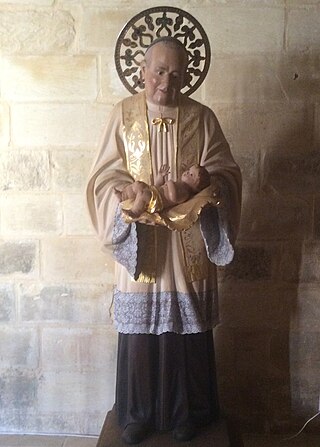
Mellieħa is a large village in the Northern Region of Malta. It has a population of 10,087 as of March 2014. Mellieħa is also a tourist resort, popular for its sandy beaches, natural environment, and Popeye Village nearby.

Saint Julian's is a town in the Eastern Region of Malta. As of 2020, its registered number of inhabitants stands at 13,792. It is situated along the coast, north of the country's capital, Valletta. It is known for tourism-oriented businesses, such as hotels, restaurants and nightclubs which are centred mainly in an area known as Paceville.

The Society of Christian Doctrine, better known as MUSEUM, is a society of Catholic lay volunteers, made of men and women, teaching catechism in the Christian faith formation of children and adults. The society was established by George Preca in March 1907, in Malta. It has eventually spread around the world, first among Maltese migrants in Australia, then in Albania, in North Sudan, and other countries.

Floriana, also known by its title Borgo Vilhena, is a fortified town in the Port Region area of Malta, just outside the capital city Valletta. It has a population of 2,205 as of March 2014. Floriana is the birthplace of many famous Maltese, amongst which the composer of the national anthem, 'L-Innu Malti', Robert Samut; former Bishop of Malta Dun Mauro Caruana, the poets Oliver Friggieri and Maria Grech Ganado, the writer and politician Herbert Ganado and Swedish Idol winner Kevin Borg.

Birkirkara is a city in the eastern region of Malta. It is the second most populous on the island, with 24,356 inhabitants as of 2020. The town consists of five autonomous parishes: Saint Helen, Saint Joseph the Worker, Our Lady of Mount Carmel, Saint Mary and San Gorg Preca. The city's motto is In hoc signo vinces, and its coat of arms is a plain red cross, surmounted by a crown.

Qormi, also known by its title Città Pinto, is a city in the Southern Region of Malta, southwest of Valletta in the centre of the island. It has a population of 16,324, making it Malta's fifth-largest city.

San Ġwann is a town in the Northern Region of Malta, with a population of 14,244 as of 2021. Prior to its establishment as a distinct municipality, it was a fragmented community comprising parts of Birkirkara and St. Julian's. San Ġwann emerged as a new parish in 1965 and was officially recognised as a town in 1968. The Local Councils Act of 1993 identified San Gwann as a separate district with its own statutory local government authority, marking its transition from being part of the neighbouring localities. With the first San Gwann Council was elected on 16 April 1994.

Santa Venera is a town in the Southern Region of Malta, with a population of 8,834 (2021). It is located between the towns of Birkirkara and Ħamrun, and also borders Qormi and Msida.

Msida is a harbour town in the Eastern Region of Malta with a population of 7,623 (2021).

Iklin is a village in the Central Region of Malta, with a population of 3,247 as at 2021. Iklin was established in the mid-20th century; however some archaeological sites and a medieval chapel, named as St. Michael Chapel, are proof to earlier settlements. Until recently, the town was considered to form part of the Three villages of Malta, as part of Lija. With the separation of Iklin from Lija, Iklin is no longer part of the three villages. It is bordered by Għargħur, San Ġwann, Birkirkara, Balzan and Naxxar.
Malta is the country with the most holidays in the European Union. Since 2020, any holidays falling on Saturdays or Sundays add an extra day to the workers' leave pool, reverting to the pre 2005 system.

George Franco Preca, T.OCarm was a Maltese Catholic priest, the founder of the Society of Christian Doctrine and a Third Order Carmelite. Pope John Paul II dubbed him "Malta’s second father in faith".

Malta is for non-local government purposes divided into districts as opposed to the local government regions at the same level. The three main types of such districts – statistical, electoral at national level, and policing – have no mainstream administrative effect as the regions and local councils function as the only administrative divisions of the country.
This page list topics related to Malta.

St Helen's Basilica is an 18th-century Roman Catholic church situated in Birkirkara, Malta. It is built on the baroque design by Salvu Borg and built by Mason Domenico Cachia. The design was inspired by, and is similar to, the Mdina Cathedral by Lorenzo Gafa. It was built to replace the role of the main old Parish Church of St. Mary that was damaged in the 1856 earthquake. It eventually became the Collegiate Church and then a Minor Basilica. The current parish archpriest is Mons Louis Suban.

In Malta, most of the main roads are in the outskirts of the localities to connect one urban area with another urban area. The most important roads are those that connect the south of the island with the northern part, like Tal-Barrani Road, Aldo Moro Street in Marsa and Birkirkara Bypass.

Ta' Ċieda Tower, also known as San Ġwann Roman Tower, is a Punic-Roman tower in San Ġwann, Malta. The exact origins of the tower could date back to pre-history with different architecture. It is argued that the tower could be of Punic origins rather than Roman but the latter have adapted it. The site of the tower was used as a cemetery, or more, during the Muslim caliphate in the medieval times. Following the expulsion of the Muslims in Malta a church dedicated to St. Helen was built on the site.






































